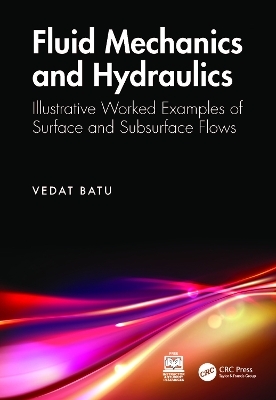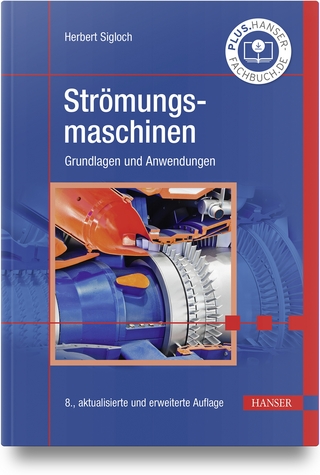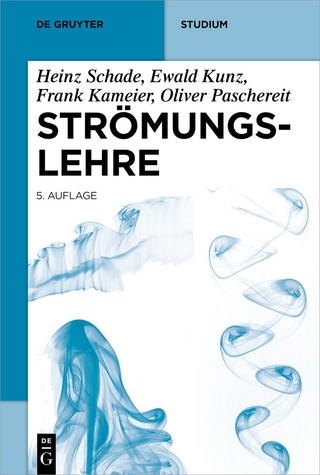
Fluid Mechanics and Hydraulics
CRC Press (Verlag)
978-1-032-60078-9 (ISBN)
- Titel z.Zt. nicht lieferbar
- Versandkostenfrei innerhalb Deutschlands
- Auch auf Rechnung
- Verfügbarkeit in der Filiale vor Ort prüfen
- Artikel merken
Fluid Mechanics and Hydraulics: Illustrative Worked Examples of Surface and Subsurface Flows presents the basic principles of fluid mechanics through the use of numerous worked examples. Some readers may have interest only in the application parts of various principles without paying too much attention to the derivation details of equations. Other readers may have interest both in derivation details and their applications. As a result, this book is designed to address both needs, and most derivation details are included as example problems. Therefore, those who are not interested in the details of derivations may skip them without interrupting the effective use of the book. It serves as an effective learning source for college students and as a teaching tool for instructors (with an included solutions manual), as well as for practicing professionals in the areas of fluid mechanics and hydraulics.
Vedat Batu graduated from the Civil Engineering Faculty of Istanbul Technical University (Istanbul, Tűrkiye) in 1969 with B.S and M.S degrees (combined) in the area of civil engineering. In the same year, he was appointed as an instructor in the Hydraulic Engineering Division of the Civil Engineering Department of Karadeniz Technical University (Trabzon, Tűrkiye). He received his Ph.D. in Hydraulic Engineering from Istanbul Technical University in 1974. He prepared his Associate Professorship thesis in Hydraulic Engineering in 1976-1977 at the University of Wisconsin, Madison. After the submittal of his thesis and passing all required examinations, he was appointed as an Associate Professor (Doçent) in the Department of Civil Engineering of Karadeniz Technical University in June 1979 and he worked as a faculty member until the end of 1982. Finally, he was the Chairman of the Civil Engineering Department. At the end of 1982, he voluntarily resigned from his position and went to the United States of America. He also served as a visiting professor in several universities in the United States and in the United Kingdom and then he joined the private sector in the US and worked on mostly environmental engineering-related projects. In Tűrkiye and the US, he taught many courses both at undergraduate and graduate levels, including hydraulic engineering, open channel hydraulics, hydrology, and ground water hydraulics for over 10 years. Since he received his PhD 1974, Dr. Batu has been involved in many scientific projects and published a number of authored and co-authored papers in some internationally-recognized journals including Ground Water, Journal of Hydrology, Journal of Hydraulic Engineering, Journal of Irrigation and Drainage Engineering, Soil Science Society of America Journal, and Water Resources Research. Dr. Batu has developed new concepts and approaches including many analytical and numerical models in the areas of aquifer hydraulics, vadose zone hydrology, and solute transport in aquifers. Besides this book, he is also the author of two others -- Aquifer Hydraulics and Applied Flow and Solute Transport Modeling. His original papers and books are cited and used as text books by many scientists and practitioners around the world, and these can be seen at http://scholar.google.com. Dr. Batu was appointed as a full professor in August 2008 in the Department of Civil Engineering of Yeditepe University (Istanbul, Tűrkiye). Currently, he is an employee of Argonne National Laboratory, Chicago, Illinois.
Part A: Fundamentals. Chapter 1: Definitions and the presentation framework of the book. 1.1 Basic definitions for the branches of fluid mechanics. 1.2 Historical background of fluid mechanics. 1.3 Presentation of the framework of the book. Chapter 2: Physical characteristics of fluids. 2.1 Introduction. 2.2 Dimensions and units. 2.3 Density, specific weight, specific volume, and specific gravity. 2.4 Compressibility of fluids. 2.5 Viscosity of fluids. 2.6 Surface tension and capillarity. Problems. Part B: Vector Analysis and Integral Theorems. Chapter 3: Fundamentals for vector analysis. 3.1 Introduction. 3.2 Scalars and vectors. 3.3 Unit vectors. 3.4 Product of vectors. 3.5 Vector differentiation. 3.6 Gradient, Divergenge, Curl, and Formulas involving ∇. 3.7 Some vector and scalar quantities in Orthogonal Coordinates System. 3.8 Some vector and scalar quantities in Circular Cylindrical Coordinates. Chapter 4: Vector Calculus and Integral Theorems. 4.1 Introduction. 4.2 Line, Surface, And Volume Integrals. 4.3 Green’s Theorem in The Plane. 4.4 Gauss Divergence Theorem. 4.5 Stokes’ Theorem. 4.6 Leibniz’s Rule for Differentiating an Integral. 4.7 Laplace Transforms. 4.8 Fourier Transforms. Chapter 5: Complex Variables. 5.1 Complex Numbers. 5.2 Holomorphic Functions. 5.3 Conjugate Functions. 5.4 Complex Differential Operators. Part C: Ideal Fluids. Chapter 6: Kinematics of Ideal Fluids Motion. 6.1 Introduction. 6.2 The Velocity of a Fluid Particle and it’s Visualized Features. 6.3 Derivation of the Kinematics Equation for a Compressible Ideal Fluid. 6.4 Kinematics Equation for an Incompressible Ideal Fluid. 6.5 Acceleration Equations of a fluid particle in the Cartesian Coordinates. 6.6 Other Forms of the Acceleration Equations. 6.7 Material Derivative Examples for Fluid Flow. 6.8 Derivation of the Continuity Equation Using Vectors. 6.9 Derivation of the Continuity Equation in the Cartesian Coordinates for Compressible Fluids. 6.10 Derivation of the Continuity Equation in a Streamtube under Steady Flow Conditions. Problems. Chapter 7: Rotational and Irrotational Fluid Flows. 7.1 Introduction. 7.2 Line Integrals. 7.3 Vorticity for Rotational Fluid Flows. 7.4 Inclusion of the Vorticity Expression into the Fluid Kinematics Equation. 7.5 Irrotational Fluid Flows. Poblems. Chapter 8: The Equation of Motion of an Inviscid Fluid. 8.1 Introduction. 8.2 Reynolds Transport Theorem. 8.3 Rate of Change of Linear Momentum. 8.4 Derivation of the Equation of Motion of an Inviscid Fluid. 8.5 The Equation of Motion of an Inviscid Fluid for Conservative Forces and Barotropic Flow. 8.6 The Zero Case of Vorticity: Beltrami Flows. 8.7 Cartesian Coordinates Forms of The Equation of Motion. 8.8 Equation of Motion Under Steady State Conditions. 8.9 Rate of Change of Circulation. Problems.
Chapter 9: the impulse-momentum principle in fluid mechanics and its applications. 9.1 Introduction. 9.2 The Impulse-Momentum Equations. 9.3 The Force and Moment of Momentum Expressions. 9.4 Applications of The Impulse-Momentum Principle. Problems. Chapter 10: Bernoulli and The Work-Energy Equations for Incompressible and Compressible Ideal Fluids. 10.1 Introduction. 10.2 Derivation of Bernoulli’s Equation for Ideal Fluids. 10.3 Some Fundamental Applications of Bernoulli’s Equation. 10.4 Worked Examples for Bernoulli’s Equation Along with The Impulse-Momentum Principle. 10.5 Bernoulli’s Equation for Adding Energy and Extracting Energy Conditions: The Work-Energy Equation for Incompressible Fluids Flow. 10.6 The Work-Energy Equation under Heat Transfer Conditions: The Work-Energy Equation for Compressible Fluid Flow. Problems. Chapter 11: Fluid Statics. 11.1 Introduction. 11.2 Hydrostatic Pressure. 11.3 Pressure Measurement and Types of Pressure. 11.4 Hydrostatic Forces on Submerged Surfaces. 11.5 Buoyancy and Flotation. 11.6 Accelerated Fluid Masses. Problems. Chapter 12: Two-dimensional fluid flow. 12.1 Introduction. 12.2 Fluid Flow in Two Dimensions. 12.3 Vorticity in Two-Dimensional Rotational Fluid Flows. 12.4 Stream Function. 12.5 Vorticity in Two-Dimensional Fluid Flows. 12.6 The Pressure Equation. 12.7 The Velocity Potential and Laplace Differential Equation for Irrotational Fluid Flows.Problems. Chapter 13: Fundamentals for Application of Complex Variables to Fluid Flow. 13.1 Introduction. 13.2 The ϕ (x,y) and ψ(x,y) Relationships and the Complex Potential. 13.3 The Complex Velocity. 13.4 Milne-Thomson’s Circle Theorem. Problems. Chapter 14: Fluid Flow Around a Circular Cylinder. 14.1 Introduction. 14.2 The Complex Potential of a Circular Cylinder. 14.3 Stream and Velocity Potential Function Expressions. 14.4 The Velocity Around the Cylinder. 14.5 The Hydrodynamic Pressure on The Circular Cylinder. Problems. Chapter 15: Conformal Representation. 15.1 Introduction. 15.2 Conformal Mapping. 15.3 The Joukowsky Transformation. 15.4 The Complex Potential for Uniform Fluid Flow Around An Elliptical Cylinder Making An Angle With The x-Axis. 15.5 Determination of The Stream and Potential Functions for An Elliptic Cylinder in a Uniform Flow Making and Angle with the x-Axis. 15.6 The Velocity Around the Ellipse. 15.7 The Hydrodynamic Pressure on The Ellipse. 15.8 Fluid Flow Past a Plate. 15.9 The Force and Moment Expressions for Two-Dimensional Steady and Irrotational Flows: The Theorems of Blasius. 15.10 Application of The Blasius Theorems to An Elliptic Cylinder in a Uniform Flow.
Problems. Chapter 16: Fluid Dynamics Around Airfoils and The Kutta-Joukowsky Lift Force Theorem. 16.1 Introduction. 16.2 The Geometry of an Airfoil. 16.3 Circulation Around a Circular Cylinder. 16.4 Flow and Circulation Around A Circular Cylinder. 16.5 The Kutta-Joukowsky Lift Force Theorem for a Circular cylinder. 16.6 Generalization of the Kutta-Joukowsky Lift Force Theorem for any closed curve. 16.7 Practical Implications of The Kutta-Joukowsky Lift Force Theorem. Problems. Chapter 17: Two-Dimensional Sources and Sinks. 17.1 Introduction. 17.2 Source and Sink in a Uniform Flow Field. 17.3 Source and Sink Having Equal Strength. 17.4 Two Sources Having Equal Strength. 17.5 Doublet. 17.6 The Method of Images. Problems. Chapter 18: The Schwarz-Cristoffel Theorem and it’s Applications to Two-Dimensional Fluid Flow in Polygonal Systems with Separation. 18.1 Introduction. 18.2 Some Flow Configurations and Basic Configurations for Simple Closed Polygons. 18.3 The Schwarz-Cristoffel Theorem for Conformal Mapping. Problems. Part D: Real Fluids. Chapter 19: Fundamentals of Real Fluid Flow. 19.1 Introduction. 19.2 Classification of Fluid Flows. 19.3 Turbulent Flow and Eddy Viscosity. 19.4 Bernoulli’s Equation for Real Fluids. 19.5 Determination of Friction Head Losses in Closed Conduits. 19.6 Empirical Average Velocity Equations in Conduits. 19.7 Minor Head Losses. 19.8 Navier-Stokes Equations for Compressible Fluids. 19.9 Navier-Stokes Equations for Incompressible Fluids and Some of Their Analytical Solutions. 19.10 The Energy Equation. 19.11 Solution of The Equations for Fluids for The General Case. 19.12 Compressible Fluid Flow. Chapter 20: Hydraulic similitude and dimensional analysis. 20.1 Introduction. 20.2 Similitude and Models. 20.3 Rayleigh Method of Dimensional Analysis. 20.4 Buckingham π Theorem Method of Dimensional Analysis. Problems. Chapter 21: Theory of fluid boundary layer and exerted forces on immersed solid bodies. 21.1 Introduction. 21.2 Fluid Flow Around Solid Boundaries. 21.3 Laminar Boundary Layer Along a Flat Plate for Incompressible Fluids. 21.4 Turbulent Boundary Layer Along a Smooth Flat Plate for Incompressible Fluids. 21.5 Exerted Forces on Immersed Objects by Flowing Fluids. Problems. Chapter 22: Flow in Pipe Networks. 22.1 Introduction. 22.2 Equivalent Pipes. 22.3 Series Pipe Systems. 22.4 Parallel Pipe Systems. 22.5 Branching Pipe Systems. 22.6 Pipe Networks. Problems.
Chapter 23: Steady liquid flow in open channels. 23.1 Introduction. 23.2 Fundamentals and Uniform Flow Open-Channel Flow. 23.3 Specific Energy, Critical Depth, And Critical Velocity in Open Channel Flow. 23.4 Gradually Varied Open Channel Flow. 23.5 Hydraulic Jump. Problems. Chapter 24: Measurement of flow of fluids. 24.1 Introduction. 24.2 Measurement of Fluid Viscosity. 24.3 Measurement of Fluid Pressure and Velocity. 24.4 Measurement of Fluid Flow Rate. 24.5 Time to Empty Tanks. Problems. Chapter 25: Mechanics of Water Wave Motion. 25.1 Introduction. 25.2 Characteristics of Water Waves. 25.3 Small Amplitude Water Wave Theory. Problems. Chapter 26: Unsteady Flow in Open Channels. 26.1 Introduction. 26.2 De Saint-Venant Equations for Unsteady Open Channel Flow. 26.3 Summary and Solution Methods of The De Saint-Venant equations. Problems. Chapter 27: Fluid Machines. 27.1 Introduction. 27.2 Jet Propulsion Mechanics. 27.3 Propellers and Fluid Turbines. 27.4 Impulse Turbines. 27.5 Centrifugal Pumps and Reaction Turbines. 27.6 Mechanics of Rotating Fluid Systems and their Corresponding Bernoulli Equation. 27.7 Analysis of Fluid Machines Characteristics with Dimensionless Parameters. 27.8 Rocket Propulsion. Problems. Chapter 28: Water hammer analyses for ideal and real fluids and their applications. 28.1 Introduction. 28.2 Simple Water Hammer Analysis for Ideal Fluids Using the Impulse-Momentum Principle. 28.3 Allievi’s Theory of Water Hammer for Ideal Fluids. 28.4 Water Hammer Theory for Real Fluids. Problems. Chapter 29: Hydrodynamics and Hydraulics of Flow Through Porous Media. 29.1 Introduction. 29.2 Natural Porous Media and Their Characteristics. 29.3 Basic Equations of Porous Media Flow. 29.4 Classification of Aquifers with Respect to Hydraulic Conductivity. 29.5 Capillary Characteristics of Porous Media. 29.6 Compressibility and Elasticity of Aquifers. 29.7 Generalized Equations of Fluid Motion in Aquifers. 29.8 Principal Hydraulic Conductivities. 29.9 Directional Hydraulic Conductivities. 29.10 Differential Equations of Flow in Porous Media and Aquifers. 29.11 Initial and Boundary Conditions. 29.12 Governing Equations for Two-Dimensional Steady Flow in Aquifers. 29.13 Application of The Complex Variables Theory to a Flat Bottom Hydraulic Structure. 29.14 Vertical Fully Penetrating Well Hydraulics Under Steady State Conditions in Cylindrical Coordinates. 29.15 Transient Vertical Fully Penetrating Well Hydraulics in Nonleaky Confined Aquifers: Theis Solution and Some Key features. 29.16 Vertical and Horizontal Partially Penetrating Transient Well Hydraulics in Cartesian Coordinates. 29.17 Inclined Partially Penetrating Transient Well Hydraulics in Cartesian Coordinates. 29.18 Approximate Differential Equations of Flow in Unconfined Aquifers in Cartesian Coordinates. 29.19 Some Unconfined Aquifer Solutions. Problems. References.
| Erscheinungsdatum | 29.05.2024 |
|---|---|
| Zusatzinfo | 27 Tables, black and white; 589 Line drawings, black and white; 589 Illustrations, black and white |
| Verlagsort | London |
| Sprache | englisch |
| Maße | 178 x 254 mm |
| Gewicht | 2499 g |
| Themenwelt | Naturwissenschaften ► Physik / Astronomie ► Strömungsmechanik |
| Technik ► Bauwesen | |
| Technik ► Maschinenbau | |
| Technik ► Umwelttechnik / Biotechnologie | |
| ISBN-10 | 1-032-60078-0 / 1032600780 |
| ISBN-13 | 978-1-032-60078-9 / 9781032600789 |
| Zustand | Neuware |
| Informationen gemäß Produktsicherheitsverordnung (GPSR) | |
| Haben Sie eine Frage zum Produkt? |
aus dem Bereich


